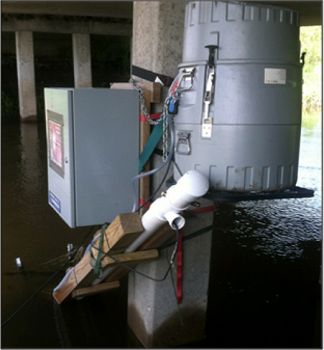Reynolds et al., 2016
Optimizing Sampling Strategies for Riverine Nitrate Using High-frequency Data in Agricultural Watersheds
Reynolds, K.N., Loecke, T.D., Burgin, A.J., Davis, C.A., Riveros-Iregui, D., Thomas, S.A., St. Clair, M.A., and Ward, A.S. (2016)
Environmental Science & Technology
-
IML, INVESTIGATOR
Abstract
An existing spatially distributed, high-frequency nitrate monitoring network covering ∼40% of Iowa provided direct observations of in situ nitrate concentrations at a temporal resolution of 15 min.
Understanding linked hydrologic and biogeochemical processes such as nitrate loading to agricultural streams requires that the sampling bias and precision of monitoring strategies be known. An existing spatially distributed, high-frequency nitrate monitoring network covering ∼40% of Iowa provided direct observations of in situ nitrate concentrations at a temporal resolution of 15 min. Systematic subsampling of nitrate records allowed for quantification of uncertainties (bias and precision) associated with estimates of various nitrate parameters, including: mean nitrate concentration, proportion of samples exceeding the nitrate drinking water standard (DWS), peak (>90th quantile) nitrate concentration, and nitrate flux. We subsampled continuous records for 47 site-year combinations mimicking common, but labor-intensive, water-sampling regimes (e.g., time-interval, stage-triggered, and dynamic-discharge storm sampling). Our results suggest that time-interval sampling most efficiently characterized all nitrate parameters, except at coarse frequencies for nitrate flux. Stage-triggered storm sampling most precisely captured nitrate flux when less than 0.19% of possible 15 min observations for a site-year were used. The time-interval strategy had the greatest return on sampling investment by most precisely and accurately quantifying nitrate parameters per sampling effort. These uncertainty estimates can aid in designing sampling strategies focused on nitrate monitoring in the tile-drained Midwest or similar agricultural regions.
Citation
Reynolds, K.N., Loecke, T.D., Burgin, A.J., Davis, C.A., Riveros-Iregui, D., Thomas, S.A., St. Clair, M.A., and Ward, A.S. (2016): Optimizing Sampling Strategies for Riverine Nitrate Using High-frequency Data in Agricultural Watersheds. Environmental Science & Technology. DOI: 10.1021/acs.est.5b05423
Explore Further


